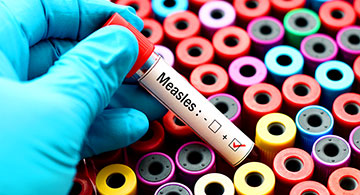By: Angeli Marie Sta. Maria-Escaño
Twitter: @ilegna_csm; Instagram: ilegnacsm; YouTube: AngeliMarie
Angeli is a graduate of the University of the East Ramon Magsaysay Memorial Medical Center and has been a lifelong writer and is a photography enthusiast. She and her husband moved to Canada in April of 2018.
 The recent rise in the incidence of Measles internationally worries not only frontline health care professionals but also health agencies worldwide such as the World Health Organization (WHO), Center for Disease Control (CDC) in the United States, Health Canada, and the Philippines’ Department of Health (DOH). In 2019 alone (a mere two months before I wrote this article), a total of 13,470 cases with 203 deaths in the Philippines were reported by the DOH as of February 22, 2019. With the ease of travel by air and sea, Canada is also vulnerable and has recorded 10 cases of measles in 2019 as of February 22, 2019. Technically, measles was declared to have been eradicated in Canada since 1998 and new cases were considered to have come from international travellers. Though majority of the 2019 cases of measles have occurred in other provinces, it was reported in multiple news agencies on February 24, 2019 that one traveller who transited through Edmonton International Airport and spent time in Leduc tested positive for measles raising an alert in Alberta.
The recent rise in the incidence of Measles internationally worries not only frontline health care professionals but also health agencies worldwide such as the World Health Organization (WHO), Center for Disease Control (CDC) in the United States, Health Canada, and the Philippines’ Department of Health (DOH). In 2019 alone (a mere two months before I wrote this article), a total of 13,470 cases with 203 deaths in the Philippines were reported by the DOH as of February 22, 2019. With the ease of travel by air and sea, Canada is also vulnerable and has recorded 10 cases of measles in 2019 as of February 22, 2019. Technically, measles was declared to have been eradicated in Canada since 1998 and new cases were considered to have come from international travellers. Though majority of the 2019 cases of measles have occurred in other provinces, it was reported in multiple news agencies on February 24, 2019 that one traveller who transited through Edmonton International Airport and spent time in Leduc tested positive for measles raising an alert in Alberta.
What is truly alarming is not the epidemiology surrounding this ongoing outbreak, but the origin and nature of the resurrection of this preventable infection. Could the fact that measles is easily preventable have made our current worldwide population lax about its devastating nature? This possibility has a historical precedent: the outbreak of Pertussis (more commonly referred to as Whooping Cough) in Japan between 1976 through the early 1980’s. By the early 1970’s Pertussis had nearly been eradicated in the Japanese islands with annual vaccination rates as high as 80%. The scarcity of reported cases and zero attributed mortality caused a lapse in vaccination, with rates dropping to as low as 10% by 1974. The disease therefore resurged in the newly vulnerable population, with over 13,000 Pertussis cases recorded including 41 deaths. This outbreak spurred both health practitioners and the general population to restart vaccinating. With the protection of vaccination, the incidence steadily declined and in 1993 reached a record low of 130 cases.
That is how vaccines work to eradicate a disease: herd immunity. As clearly seen with the Pertussis outbreak in Japan, vaccines are not a cure—they are prevention. Vaccination is an efficient way of stopping the spread of an infectious disease within a population—the “herd”— by creating a sufficiently high proportion of individuals that are immune to the disease. Without vulnerable unimmunized individuals that can become reservoirs of the infective entity, the disease does not spread and is eventually eradicated. With lapses in vaccination, however, the disease has a chance to spread and over several replications can mutate into more severe forms (more virulent strains), making it harder to cure and eradicate.
This is the origin of the current outbreak of measles: the anti-vaxxer movement. Lately trending through many social media platforms, anti-vaxxers have steadily gained momentum in their fight to forward their beliefs about the dangers of vaccination. Although critics of vaccination have been present since the 1800s, the modern anti-vaxxer movement was said to have originated from British gastroenterologist Andrew J. Wakefield, who published a study claiming that the measles-mumps-rubella (MMR) vaccine was linked to autism. His study was debunked multiple times after other researchers could not reproduce his study’s results (a core principle of the scientific method); Wakefield then lost his license to practice medicine as he was found to have faked his study’s data and that he acted unethically and dishonestly to the detriment of the public. Primum non nocere, first do no harm.
In the Philippines, ill-founded suspicions and accusations against the new vaccine on the market for Dengue (Dengvaxia) possibly spread hysteria among parents in the Philippines, many of whom were poorly informed and therefore hesitated to have any vaccine administered to their children. A blanket refusal to vaccinate, including proven safe vaccines, which include the MMR vaccine, created the opening for the infection to spread and mutate. The Philippines is not the only place to look into as a source for the lapse in vaccination, as there have also been outbreaks in Europe, Africa and the USA.
In the age of information, the challenge to show the anti-vaxxer movement the true principles behind the use of vaccination is unfortunately more complicated. With the ease of access via the internet and social media, information has now become muddled into war against misinformation. Social media platforms have become the fishing ground for anti-vaxxers to bait their next catch. The definitive reason for vaccine hesitancy was distrust in its worth. In a slippery slope line of reasoning stemming from the vaccine-autism fib, anti-vaxxers claim that vaccines were only propagated by big pharmaceuticals for increased income and were likely laced with toxic substances that were more harmful than good. Suceptible individuals were baited, converted, and in a strange twist, indoctrinated into the belief to the point of cultish fanaticism. The movement has become an even more dangerous contagion than just the one disease that is spreading now. Some anti-vaxxers have also refused to vaccinate their pets, allowing for other diseases that can have animal reservoirs, such as rabies, to spread. Even if you explain the economics of research, safety testing and vaccine production to answer their big pharma argument against vaccines, they will not yield in one sitting. Scare tactics will not persuade anxious parents, only time, effort, and a calm demeanor will.
Moreover, not all anti-vaxxers are motivated by their desire to keep the public away from these supposed harmful vaccines; hiding behind some anti-vaccine groups and sites were lightly veiled attempts to sell non-regulated and untested products such as dietary supplements, as reported on MSNBC’s Velshi and Ruhle aired on February 22, 2019. To combat the ill effects of the anti-vaxxer propaganda, Pinterest was the first social media platform to put forth its new policy against it, banning both pro and anti-vaxxer searches. Other social media platforms followed suit, but apparently, their policy was not as decisive as the one adopted by Pinterest. In my own dive into social media and cable news in the last two weeks, there was not enough coverage of this international health crisis in my opinion. It will take years to build the herd immunity back up like what Japan went through for their 1970s Pertussis outbreak, even if reports now suggest that some anti-vaxxers have begun to vaccinate their families due to the measles outbreak.
It is highly likely, with the statistics regarding the ongoing measles outbreak, that you or someone you know has been affected (whether directly infected or inconvenienced) by the resurgence of this very preventable disease. I personally have a young adult nephew (J.G.C.,III) back in the Philippines, who suffered much, requiring hospitalization and intense treatment for complications of a more virulent strain of measles despite his complete battery of childhood immunizations. It is to him and his competent health care team that I dedicate this article. In my social media accounts, I have spoken out regarding the need to re-educate and vaccinate for not just each individual’s safety, but for the greater good. I appealed to my friends in health care to use their considerable talents and use the respect they gained as educated professionals to speak out and be heard. Only by not adding fuel to the fire and dowsing the flames with solid reasoning can a wildfire like this be contained. And in this moment of writing inspiration, I end this article with a question: what have you done for the greater good?


